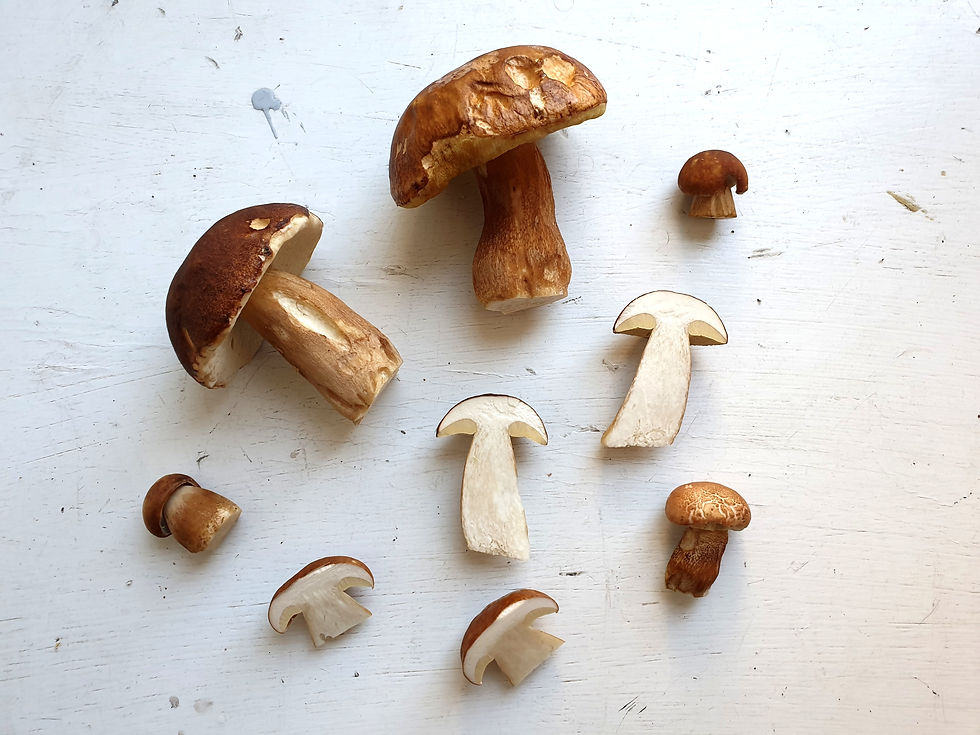The Boletus Edulus - Where to find Porcini Mushrooms
- Jenifer

- 22. Juli 2020
- 3 Min. Lesezeit
Porcini are amongst the most favourite edible mushrooms in the woods. You can use them for risotto, ragout or add them in a pasta sauce for extra flavour - porcini are a multi-talent in the kitchen.

You can dry them or freeze them, to use them later for some delicious risottos or ragouts.
To freeze them, simply clean them with a knive and a brush, cut the mushrooms into pieces and put them in a freezer bag into the freezer. Try to avoid washing them - they soak with water quickly and lose their falvours. When frozen raw, procini stay fresh for about 12 months. You also can freeze cooked dishes with porcini - they stay fresh in the freezer for about 3 months. What's important - don't defrost them, process them right away.
To dry the porcini, cut the cleaned mushrooms into slices and place them on a kitchen towel. Put them in a warm and dry place until they are completely dried - no direct sunlight. Store the dried mushrooms in a dark, sealable glas.
Where to find them...
There are up to 7 different species of porcini mushrooms. They all prefer different biospheres and can be found in different woodland sceneries.
The first porcini mushroom to appear throughout the year is the summer bolete. When it is warm enough, you can find the sommer bolete as early as end of mai. The penny bun, black porcini and the pine bolete can be found between july and november. Porcini mushrooms dissapear with freezing temperatures.
The summer bolete can be found in open beech woodlands. They also might appear by the wayside. The most promising are beech woods with loads of deadwood on the grounds, openings in the tree crowns and little grass.

You also can find loads of porcini mushroom throughout spruce woodlands. Spruces grow in the uplands. Also look for sunny and warm places to find the penny bun. To find the pine bolete, you need to be extra lucky - it is scarce.
Look out for indicator plants...
When looking for mushrooms, finding the right woodlands isn't the only thing that counts.
Look out for indicator plants! They will lead you to the right spots. When you spot a fly agaric, the procini mushrooms might not be too far. Both mushroom species prefer the same biosphere. If you find a lot of nettle, move on. They prefer nitrogenous soil, which porcini mushrooms clearly don't like.
How to correctly identify them...
You have been succesful in your search? Now is the time to correctly identify the mushrooms found. As a rough guide, porcini mushrooms wear white mesh hose. Especially with younger specimens, you can indicate a white mesh structure on a brown surface on the stalk. If you find a brown mesh structure on white surface, you hold a bitter bolete in your hands. They are not toxic, but taste very bitter - even a small piece would make the whole mushroom dish taste bitter.
In case of doubt, a smell and taste test might help. The bitter boletus is nearly odorless and tastes really bitter - cut off a small piece of the mushroom and hold it to the tip of your toung. If it tastes bitter, then it certainly is the bitter boletus. If the mushroom in your hand changes the colour when touched, then you likely found a specimen of the bay bolete. They are likewise edible, but not as fragrant as porcini mushrooms.

The porcini mushrooms wears a 5-35cm wide hat. In younger specimens, the hat appears light brown and switches to a darker tone later. The stalk is usually white to a greyish brown. As already mentioned, you can spot a white mesh structure on the stalk. The characterictic feature of the boletus mushrooms is a tubular sponge underneath the hat. It can be removed easily. In younger specimens the tubular sponge appears white and turns yellowish to olive green later. In older specimens, the sponge is simply removed with a knive. The flesh appears white and solid. Cut the mushrooms into halves to see if you collected quality poricini mushrooms - maggots could have been quicker.
In case of doubt, call your local service point for mushrooms identification.
Kommentare